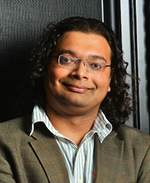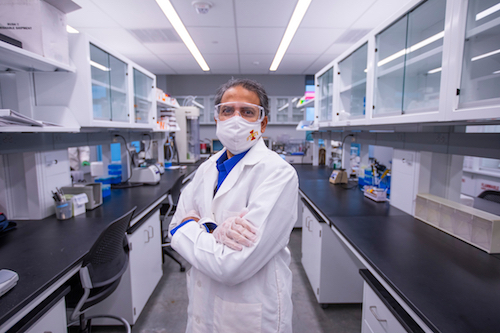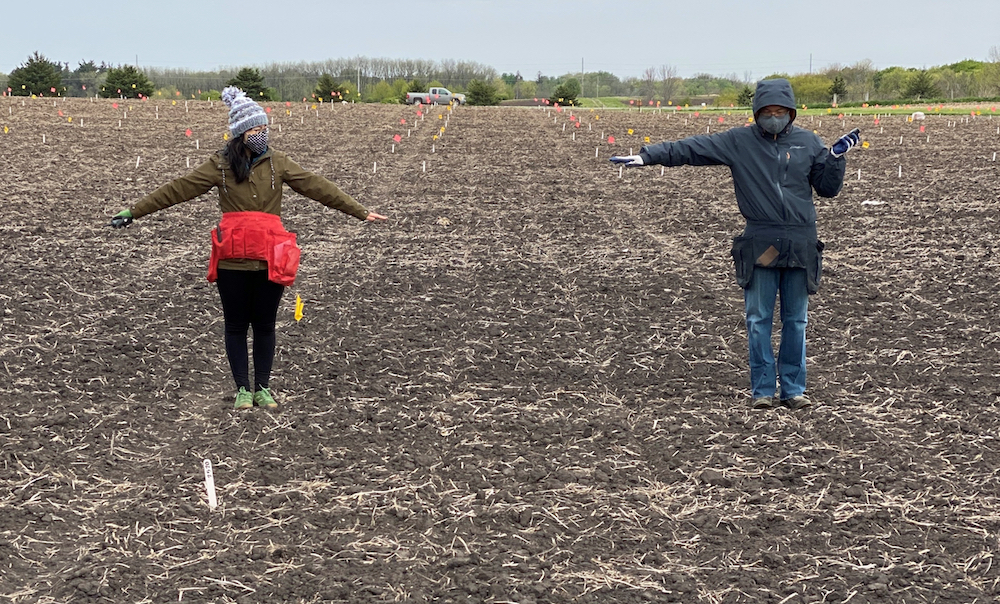
This is the look of COVID-19 social distancing in an Iowa State research plot, as demonstrated by, left to right, Shu-Ting Tsao and Cheng-Ting Eddy Yeh, of Patrick Schnable's research group. Larger photo. Photo by Patrick Schnable.
By Mike Krapfl, News Service
AMES, Iowa – One year ago, Qiang Liu thought she was heading home to Qinhuangdao, China, for a quick visit with family, especially her grandparents who missed her.
But the coronavirus that causes COVID-19 was already changing the world. And it quickly upset Liu’s life and work as an Iowa State University doctoral student.
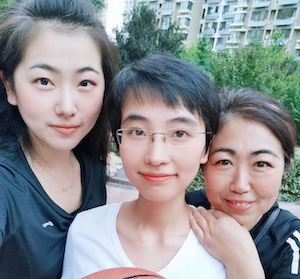
She would not be allowed to return to Ames to continue her studies of maize genetics and genomics. She would stay in China, her visa process suspended and her passport kept at the U.S. embassy. Her husband Jingzhong, meanwhile, was back in the States, working as a postdoctoral research associate in Houston.
So, like the entire Iowa State research enterprise this past year, she was forced to make new plans, both in the lab and online.
Her work is overseen by Patrick Schnable, a Charles F. Curtiss Distinguished Professor in Agriculture and Life Sciences, the Iowa Corn Endowed Chair in Genetics, the Baker Scholar of Agricultural Entrepreneurship and director of the Plant Sciences Institute.
As part of a much larger effort to keep agricultural field and lab studies moving ahead this past year (more on that below), the Schnable Lab found a way for Liu to continue her work, including hiring a former undergraduate lab assistant, Sasha Fetty, to be Liu’s hands in the lab and field.
And, of course, there were lots of virtual meetings – always in the morning here and late at night in China.
“We had many Zoom meetings for plans, protocols, problems and the results of experiments,” Liu said. “Then I could analyze the data remotely – even in China.”
Liu hopes her long-distance work is nearly over. She has a visa application appointment in February. Chinese students planning to study abroad are being vaccinated. So she’s hoping to return to Ames in April or May, with the goal of finishing her doctorate in 2022.
It’s still hard to be so far away from her studies – and her husband, of course. The couple has a Zoom call most every day, sharing stories and being part of each other’s daily routine.
“Except on Saturday,” she said, “when I visit my grandparents.”
Planning with ‘insufficient information’
A March 19, 2020, memo from Sarah Nusser, who finished her term as the vice president for research last summer and is now a professor of statistics, aptly summarized the early days of the pandemic across campus: “There’s no doubt we are in unchartered territory, but we’re doing so together.”
That memo outlined the first steps taken to keep research projects moving ahead, including:
- “Iowa State University research is continuing, but research and creative activities should be conducted differently to maximize social distancing.”
- “Research activities that can be performed remotely (e.g. writing, analysis, computation) must be conducted off-campus …”
- “All researchers should immediately begin developing contingency plans to prepare for curtailing all but the most essential on-campus research and creative activities.”
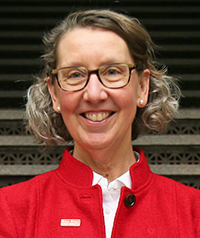
Nusser remembers attending a March meeting of senior research officers from Association of American University schools. The Nashville meeting was full of talk about the precautions and protocols universities were planning for their research programs. And some of those research officers were being called back to campus to help make decisions about moving ahead.
“Should our campus research be shut down?” Nusser remembers people asking. “Or is that too much? There was insufficient information to decide on the right path.”
At Iowa State, a Research Continuity Working Group co-led by Nusser and Jerry Zamzow, an associate vice president for research, went to work with the associate deans for research to quickly develop guidance for researchers.
Updated memos and protocols went out through the spring. In April, for example: “Face coverings and gloves are recommended.” And in May: “It is time to carefully plan and methodically implement a phased return to normal research operations ...”
“We labored over those words,” Nusser said.
The plans evolved over time and included everything from checking freezers, caring for animals, paying extra attention to lab safety, thinking about graduate students, rotating lab schedules to increase social distancing, transitioning to more telework and planning to return to campus.
“We never did shut down,” Nusser said. “I think that’s really a hallmark.”
Stay three corn rows apart, please
The pandemic changed campus research as planting season was just weeks away. That had agricultural researchers wondering if there was a way to safely plant, grow, harvest and analyze their research plants across a full growing season.
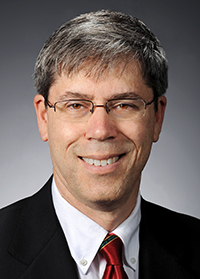
“We were very concerned,” Schnable said. “A growing season is a lot like compound interest in your retirement plan. If you miss a year, you can never make it up.”
So researchers and administrators started working up plans and procedures. The early safety plan for maize genetics prepared by Schnable and Lisa Coffey, a research scientist at the Plant Sciences Institute, (with input and review from others), noted that, “Fortunately, many aspects of field-based research can be organized to exploit extreme physical distancing.”
Plans included driving alone to field sites. Using walkie-talkies or cell phones for in-field communication. And assigning field equipment to specific people.
But what do you do with a machine-planting system that calls for two people to sit side by side for long, busy days?
Schnable said two married staff members in his research group – Cheng-Ting Eddy Yeh, a data scientist, and Shu-Ting Tsao, an administrative specialist – volunteered to move from their computers to the planter.
“Dedicated ISU employees!” Schnable said.
Later field/farm protocols from the College of Agriculture and Life Sciences quantified safe distancing between people at farm sites: “For example, as a rule-of-thumb, in a field planted at 35” (Curtiss Farm) or 30” (Agronomy Farm) row spacing would involve maintaining a minimum separation of 2 or 3 rows, respectively.”
It worked. There was a full season of field work – though there was a major interruption caused by the Aug. 10 derecho. (But, always on the lookout for data, Schnable said the wind storm provided unexpected information about stalk and root strength.)
Schnable gives university administrators a lot of credit for understanding the need to find safe ways to keep research going in labs and offices, farms and fields and even at home.
“It was important,” he said. “We can never get 2020 back again. But it was also difficult to do safely. So we developed a plan.”
And, he said, “We let everybody know we took this seriously.”
Read the series
Learn more about ISU’s pandemic response in a collection of stories highlighting some of the hard work, dedication and collaboration across campus.

